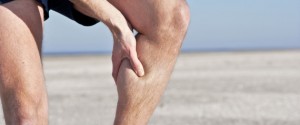 Cramps are essentially muscle contractions, just like the contractions that make your muscles move, but gone terribly, horribly, painfully wrong.
Cramps are essentially muscle contractions, just like the contractions that make your muscles move, but gone terribly, horribly, painfully wrong.
When a muscle cramps, the contraction is involuntary. “In order to have the contraction, the nerve or a group of nerves has to be activated,” says Allan Goldfarb, Ph.D., an exercise physiologist and a professor in the department of kinesiology at the University of North Carolina, Greensboro. “Some irritation or activation of that nerve [causes it to] fire when you’re not trying to make the muscle contract.” Under normal conditions, after the muscle contracts, the brain would signal for it to relax. During a cramp, that relaxation signal doesn’t come in so loud and clear, says Goldfarb. Instead, there’s an “imbalance between the activators versus the inhibitors,” he says, and the contractions continue until you’ve got yourself a full-blown cramp.
But why that imbalance exists to begin with is still a bit of a mystery. One common theory is that the cramping muscle is simply over-tired. Such exertion could be the result of holding a particular yoga pose for a lengthy period of time or pumping out a whole bunch of calf raises.
Many an experienced crampee will tell you dehydration is the culprit. But science isn’t so sure. Dehydration does certainly cause imbalances in the body, particularly of fluids and salt, says Goldfarb, but dehydration affects the whole body, not one localized muscle. “If it’s a systemic problem like dehydration, then why doesn’t the whole body cramp?” University of Cape Town sports physician Martin Schwellnus posed to the Globe and Mail.
It may be that dehydration and related depletion of minerals like potassium, magnesium and calcium may simply increase your risk of cramping in the right (er, wrong?) scenario, says Goldfarb, rather than being the distinct cause of the cramp.
A number of medications — and not just those that cause you to lose fluids — list muscle cramps as a side effect, WebMD reported. And we can’t totally rule out a simple (yet poorly understood as of yet) genetic predisposition, either, says Goldfarb.
Sometimes a cramp is brought on by a simple external trigger the body would usually control for, like a cool breeze over an exposed leg while you sleep after a hot and sweaty day at the beach, he says. “You set up your system to have an imbalance,” says Goldfarb, and then that gentle breeze or a jog on the sand or jumping rope becomes more problematic.
The good news is that most muscle cramps can be gently massaged or stretched away in a matter of minutes. And more often than not, a cramp isn’t much to worry about, says Goldfarb. The worst cramps may leave you with tiny tears in the muscle that could take a couple of days to heal. In rare cases a more serious health condition could be behind the pangs, according to the National Institutes of Health, including a spinal cord injury or a pinched nerve. If you find yourself cramping regularly, it’s time to see a physician, says Goldfarb.
Until there’s more definitive research, it certainly can’t hurt to stay hydrated and keep electrolytes balanced during longer, more tiring workouts.
HUFFINGTONPOST





Please let me know if you’re looking for a writer for your site.
You have some really great posts and I believe I would be
a good asset. If you ever want to take some of the load off,
I’d really like to write some content for your blog in exchange for a link back to mine.
Please send me an email if interested. Many thanks!